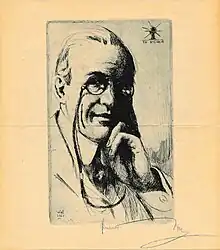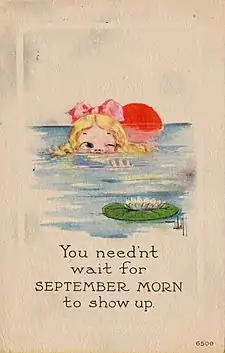Bernhardt Wall
Bernhardt Wall (December 29, 1872 – February 9, 1956) was an American etcher, lithographer, and historian.[1] He designed more than 5,000 postcards for various companies, earning him the epithet "Postcard King".[2] Wall also established himself as an etcher of famous American political and cultural leaders, particularly Abraham Lincoln.[3]
Bernhardt Wall | |
|---|---|
| Born | December 29, 1872 Buffalo, NY |
| Died | February 9, 1956 (aged 83) Sawtelle, Los Angeles |
| Known for | etching, lithography, drawing, book illustration, portraiture |
| Spouses | |
| Parent(s) | Fredrich and Freda (née Hulty) Wall |


Wall was born in Buffalo, New York, to German immigrant parents.[4] He showed an aptitude for art starting at an early age and eventually became a student of James Francis Bacon, Henry Reuterdahl, and William Auerbach-Levy.[4]
After briefly studying at the Art Students League in New York, he searched for lithography employment and concurrently worked as a watchmaker and photographer.[4][1] In August 1893, Wall left New York for a tour of the western United States, meeting Jennie Hunter (later his wife) while making sketches in Fort Gibson, Texas.[4][3] He subsequently lived in San Antonio and Houston for short periods, briefly serving as art editor of The Gulf Messenger, a women's literary journal published in Houston, all the while creating sketches of historic sites and portraits of famous people.[4][5]
Wall returned to New York, where he enlisted in the 202nd New York Volunteer Infantry Regiment during the Spain-American War.[4] While in Cuba aboard the Minnewaska, he sketched the Maine before the ship sank in the Havana Harbor.[4] Following the war, he worked in New York as a commercial artist, producing an array of colored postcards, many of them comical.[3][4]
He took a trip to Texas in 1899 and married Texas-native artist Jennie Hunter on December 25.[4] In 1900 the couple moved to New York and established a residence and studio located at 1947 Broadway.[4] Wall illustrated two children's books during this period: The Sunbonnet Twins: a Story in Verse and Music for Little Tots (New York: Cupples & Leon, 1907) and Little Karl: a Story for Children (New York: Cupples & Leon, 1908).[4]
Wall delivered lectures across New England, mostly focusing on his adventures drawing and etching portraits of the famous.[4] He also became interested in covered bridge preservation, sketching many bridges across the U.S. and serving as the president of The Covered Bridge Preservation Society for several years.[4]
After a stint as a soldier in World War I, he returned to New York, where he continued to produce postcards, and many of them were patriotic cards based on the war.[3][4] By his career's end, he had created over 5,000 postcards.[3] He had a successful exhibition of his etchings, drawings, and watercolors in 1915—by this time he had decided to abandon his career as a commercial artist and focus on etching.[4] Wall had earlier studied etching under William Auerbach-Levy, and the teacher had given him a copy of Frank Short's On Making Etchings (London, 1888), which influenced the artist's technique.[4] The artist created etchings based on the lives of notable American historical and cultural figures, capturing the likenesses of Andrew Jackson, Thomas Jefferson, Sam Houston, Woodrow Wilson, Franklin D. Roosevelt, Edgar Alan Poe, Mark Twain, and Abraham Lincoln.[3]
In 1915 he visited Colorado, Nevada and California, making etchings of Native Americans, cowboys, and major cities which were later published in the portfolio Under Western Skies, which led to the artist becoming a historian of the region.[1] He published two books of etchings (World War Etchings, 1919; Smaller World War Etchings, 1920) based on sketches he made during WWI, and both were successful.[4] These were followed by a book featuring etchings of dogs, Man's Best Friend, which was published in 1920 and quickly sold out.[4]
In 1924 Wall and his wife moved to New Preston, Connecticut, and by 1929, they had started wintering in La Porte, Texas.[4] Wall subsequently published three books related to the area in the mid 1930s, including Following General Sam Houston, 1793-1863.[4]
The couple purchased a small house near Lime Rock, Connecticut, and Wall opened an etching studio there, which was across the street from Dard Hunter's paper mill.[4] Between 1931-1942, Wall serially published Following Abraham Lincoln, an 85-volume set that illustrated Lincoln's life—each volume contains five original etchings.[4][3] By the end of his career, Wall had published eight illustrated books and 523 etchings based on Lincoln.[3][6]
In addition to creating etchings for his books, he also wrote, designed, printed and bound them.[3] He also designed many bookplates.[3]
After Jennie's unexpected death in 1938, Wall married Doris Turner, and the couple moved to Sierra Madre in 1944.[4] His last etchings were made there.[4] While in California, he was active in the Lincoln Fellowship of Southern California, and several issues of its annual publication feature a tipped-in etching of Lincoln.[4] After finally settling in Pasadena, Wall died in Sawtelle, Los Angeles, on February 9, 1956.[4][6]
References
- "Bernhardt Wall - 71st Regt Armory New York City". www.artoftheprint.com. Retrieved 2023-10-18.
- "Bernhardt Wall - Artist, Fine Art, Auction Records, Prices, Biography for Bernhardt T. Wall". Askart.com. 1956-02-09. Retrieved 2013-08-12.
- "Lincoln in Art: Bernhardt Wall – Illinois History & Lincoln Collections". 2022-08-16. Retrieved 2023-10-18.
- Weber, Francis J. (1994). Following Bernhardt Wall, 1872-1956 : Bio-bibliographical Sketch. Austin, Texas: Book Club of Texas. OCLC 702714790.
- Association, Texas State Historical. "Foute, Laura Elizabeth Bibb". Texas State Historical Association. Retrieved 2023-10-18.
- "Bernhardt Wall Obituary". Daily News-Post and Monrovia News-Post. February 13, 1956.
External links
 Media related to Bernhardt Wall at Wikimedia Commons
Media related to Bernhardt Wall at Wikimedia Commons- Bernhardt Wall at Find a Grave
- Inventory of the Bernhardt Wall Collection at Cushing Memorial Library